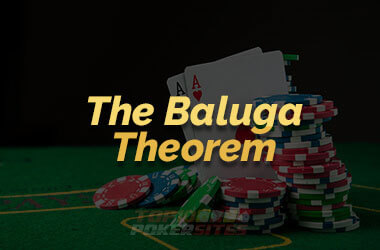Baluga Theorem in Poker Explained
The Baluga theorem is among the top three poker theorems today. Read my guide to learn what it is, how it works, and whether it’s effective.
 Poker strategy is a vast and ever-evolving field. Every new generation of poker hotshots contributes to it, so it can be hard to keep track. Nevertheless, a few theorems have held up well over time.
Poker strategy is a vast and ever-evolving field. Every new generation of poker hotshots contributes to it, so it can be hard to keep track. Nevertheless, a few theorems have held up well over time.
The Baluga theorem is one of the most popular. If you’re not sure what this concept refers to, continue reading.
We’ll discuss the Baluga theorem and explore its functionality and effectiveness below.
What Is the Baluga Theorem?
The Baluga theorem is a piece of poker strategy that first appeared around 2006. It was posted on a 2+2 forum by an individual with the username BalugaWhale, which is where it gets its name. It’s usually considered part of the “old school” era of poker with the likes of the:
- Zeebo theorem
- David Sklansky theorem
- Yeti theorem, and so on
The Baluga theorem is quite extensive and detailed, but its essence is pretty simple. It reads; “You should strongly re-evaluate the strength of one-pair hands in the face of a raise on the turn.” To better understand what BalugaWhale meant by this statement, we’ll look into the meaning of each of its parts.
The core of the theorem is advice regarding your actions at the turn, so we’ll start there. The turn is a bridge between the flop and the river. While many players neglect it, it’s critical because of the risks players have to take during this round. The pot has usually already become large by this point in the game, so deciding to commit to hands or give up on them becomes very significant.
The stakes are even higher if you’re facing a raise.
The theorem suggests that a raise is a clear sign of a strong hand. Your opponent wouldn’t be making a risky move on the turn since there’s little room for improvement. There’s only one street left in the game. If they choose to raise, you have to assume they have at least a two-pair.
However, Baluga doesn’t only discuss facing a raise on the turn. It addresses facing a raise with one-pair hands. The term one-pair hands covers a range of holdings, so the advice might initially sound confusing. Nevertheless, the theorem specifically refers to top-pair hands.
Top-pairs can win the pot, especially if they’re as strong as a pair of aces. As a result, many players put too much faith in that hand and forget to consider their opponent’s game plan. They don’t take into account that their opponent’s raise is a sign that they likely have a monster.
To that end, Baluga advises players to re-evaluate the strength of their top-pair hand in the face of a raise. It suggests they look back on their entire hand, think about their perceived range, and consider their opponent’s range. Folding might be your best option here.
Baluga Theorem in Action
The theoretical explanation of the Baluga theorem we’ve provided above should be helpful. However, it might not be enough for all players to understand it fully. We’ve put the theorem into context below to provide more clarity.
Let’s say you’re holding an A♥K♦ hand and sitting in UTG in a 6-handed NLH game. You’re the first to act before the flop, holding two of the strongest cards in the deck, so you decide to raise 4BBs. Only one player in a late position calls behind you, so you both go to the flop.
The flop shows A♥9♣3♦. It’s basically an ideal flop, so you wager 8BBs — a bet that’s approximately the size of the pot. The turn adds a 7♣ to the table, so you’re looking at A♥9♣3♦7♣. The addition of the 7♣ opens up the possibility for a flush and straight. You decide that a ¾ pot size bet is the best option as it should undermine any drawing hands’ odds to call. Nevertheless, your opponent raises this bet.
The ball is back in your court, and the situation has become complicated. Our top-pair hand prompted us to focus on exploiting it, so we completely disregarded the possibility that our opponent had a stronger hand. The purpose of the Baluga theorem is to prevent getting into this situation in the first place. It suggests we should always examine the strength of our one-pair hand and fold most of the time in this spot.
How Effective Is the Baluga Theorem in Today’s Texas Hold’em?
As mentioned earlier, the Baluga theorem has quite a few years under its belt. It was one of the top poker tactics back in the early 2000s. However, much has changed in the poker scene since then. So, many players question its effectiveness today.
To answer this question, we need to consider several things, the first being the way poker theory has evolved over the last few years. The game grew in popularity, and the size of the poker community reflects that. The increased interest in poker brought about more theories, strategies, and tactics. Players now have access to a greater range and better material than ever. Those who started dabbling in poker in the early 2000s have had plenty of time to hone their skills and expand their knowledge. So, players won’t be making the same decisions they would’ve made when the Baluga first appeared.
A quick skim of the popular poker forums will reveal players nowadays aren’t afraid to be aggressive, even if they’re playing recreationally. They’re more likely to raise with weaker hands and bluff than ten years ago. So, does this make the Baluga theorem ineffective?
Yes and no. As with most poker strategies, opinions on the Baluga are conflicted. A ton of players claim that deviations from what the theorem suggests are still rare. Most players would not raise on a turn with anything less than a strong top-pair, especially if they’re not particularly experienced. So, raises on later streets deserve respect, as the Baluga suggests. However, there are still a number of poker enthusiasts who disagree and claim the current poker landscape makes the theorem outdated.
Overall, we cannot deny that the Baluga is still a significant piece of poker theory. However, that doesn’t mean players should rely on it blindly. Your opponents’ play and experience should play a key role in your decision whether to rely on the Baluga.
Baluga vs. Other Theorems
The Baluga theorem is one of the most-discussed theorems on poker forums, but it’s not the only one. It’s neck-and-neck with Zeebo and Clarkmeister’s theorems in popularity. Let’s discuss both and see how the Baluga stacks against them.
Zeebo’s theorem assumes that no player folds a Full House, regardless of the size of the bet. It suggests that most players overestimate boats because they’re usually strong. However, that’s not always the case. The theorem advises players to bet out every time they believe their opponent might have a weaker boat.
Clarkmeister’s theorem claims that you should always bet when you’re out of position, heads up on the river, and a Four to a Flush card comes along. It suggests that most opponents will fold hands like weak or middle Flushes here, so it’s the perfect spot for bluffing.
The Zeebo beats both the Baluga and the Clarkmeister on the positive response scale. Most players still religiously stick to it since the principles it’s based on haven’t changed. Full House is still a well-known strong hand, and it’s still a hand that rarely comes around. Your opponent will rather believe you’re bluffing if you hint you have a better hand than fold a Full House.
Clarkmeister’s theorem isn’t as foolproof as Zeebo’s, but it’s on par with the Baluga. It should be effective when you’re facing less experienced players. However, it might not work against seasoned players since they’re more likely to be familiar with it.
Best Poker Rooms To Play Online Tournaments
My list of the best poker sites which I consider to be the best rooms to play in 2024:- 100% Legal & Licensed
- Verified Bonus
- Mobile Friendly
- Advertiser Disclosure
Kindly be aware that some links on Top 10 Poker Sites are affiliate links, for which we may earn a commission. Find out more on our terms & conditions
- Must be 18+ to participate.
Displayed 3 of 8 rooms
Conclusion
The Baluga theorem is among the most famous poker theories of the past two decades. While it’s not bulletproof depending on the opponent you’re facing, it can be of great help. It reminds players of the importance of the turn, pushes them to think their decisions through, and is a great crutch to lean on in sticky situations.FAQs
What’s the Baluga theorem in poker?
The Baluga theorem is a poker theory that suggests you should rethink the strength of your top-pair hand when facing a raise on the turn.
Where did the Baluga theorem come from?
Andrew Seidman posted the Baluga theorem on a poker forum under the username BalugaWhale. He has since written books on poker theory and become well-known in the community.
Is the Baluga theorem applicable today?
Poker theory has advanced a lot since the Baluga theorem appeared, so the strategy might not work in 100% of cases. However, it’s still effective against most recreational players.



